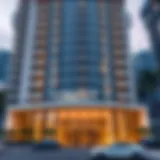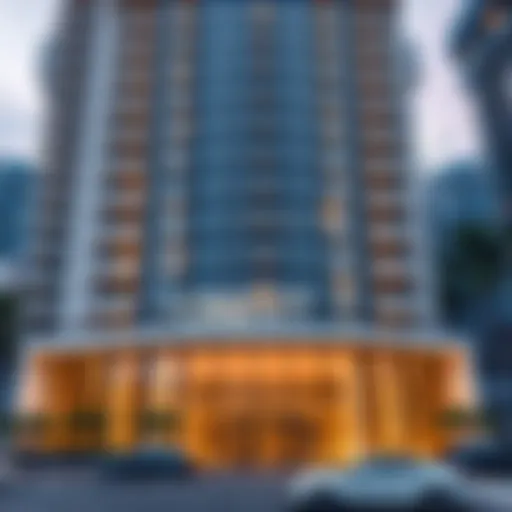Bur Dubai Abra Station: A Cultural and Historical Hub
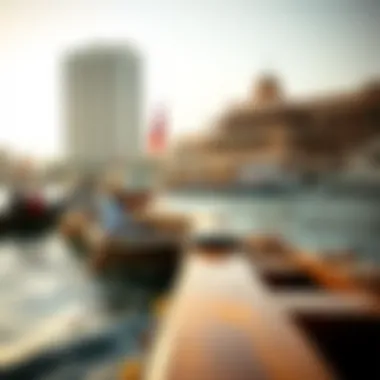

Intro
Bur Dubai Abra Station sits quietly along Dubai Creek, often overlooked by those racing past in cars or on bustling highways. This station isn't just a mere stop for transportation; it’s a lively juncture where past and present collide. With its wooden abras cutting through the creek, the station serves as a bridge connecting the rich tapestry of Dubai’s history with its modern skyline.
As we wander through the various aspects of Bur Dubai Abra Station, different themes emerge. There is a dynamic interplay between traditional culture and progressive urban development. By examining its operational significance and cultural implications, we unravel the narrative that makes the station a vital artery in the beating heart of Dubai. Not only does this transport hub cater to daily commuters, connecting them to their workplaces and homes, but it also draws tourists eager to experience the city's history.
The creek has historically been the lifeblood of Dubai, facilitating trade and cultural exchange. With the Abra Station acting as a gateway, it transforms the way we view transportation within the urban sprawl. It’s a perfect blend of efficiency and charm, making it an enduring symbol of the city’s evolution. Throughout this exploration, we'll delve deeper into the broader economic and cultural impacts that this small yet significant site holds in the ever-evolving Dubai landscape.
Foreword
The Bur Dubai Abra Station stands not only as a transit point in Dubai but also as a symbolic threshold to the city’s rich tapestry of history and culture. This article sheds light on the intricacies of the Abra Station, where tradition interlaces with the rapidly evolving urban landscape of Dubai. By providing insights into the station's operational aspects, its historical significance, and its impact on tourism and transportation, we aim to paint a vivid picture of its role as a cultural waypoint.
Understanding this station’s influence allows investors, home buyers, real estate professionals, and renters to appreciate how transportation hubs enhance property values and foster vibrant community interactions. The station is more than just a means to cross the Dubai Creek; it's a lifeline connecting bustling markets, heritage sites, and modern amenities. Additionally, exploring its evolution contributes to a broader understanding of transportation trends in Dubai, which have seen dramatic shifts—balancing historical reverence with contemporary demands. By delving into the narratives surrounding the Bur Dubai Abra Station, readers can gain insights advantageous not only for personal interests but also for strategic investment decisions in a burgeoning economic landscape.
This exploration will not shy away from the challenges this iconic station faces today, from infrastructure limitations to environmental considerations, providing a balanced view essential for those looking into the future of Bur Dubai and its transport systems. Hence, we lay the groundwork for a detailed examination of how Bur Dubai Abra Station embodies the essence of connectivity—linking people, cultures, and histories in one of the world's most dynamic cities.
"Transportation is about more than just moving from point A to point B; it’s about weaving together the fabric of a community."
As we traverse through the various aspects of Bur Dubai, we will illuminate how the Abra Station serves as a cornerstone of urban mobility, tourism, and cultural exchange, making it vital not just for locals but also for the cosmopolitan fabric of Dubai as a whole.
Navigating to Bur Dubai Abra Station
Understanding how to navigate to Bur Dubai Abra Station is essential for anyone keen on exploring the rich layers of history and culture that Dubai offers. This transportation hub acts as a vital artery, connecting various neighborhoods and attractions, making it easier for residents and tourists alike to traverse the city. Knowing its exact location and how to get there not only enhances the overall experience but also deepens one’s appreciation of the interwoven historical threads that define Dubai.
Location and Accessibility
Bur Dubai Abra Station is strategically situated along the Dubai Creek, a focal point since the city’s formative years. The station can be found at the intersection of two historically significant areas: Bur Dubai, known for its traditional markets and cultural heritage, and Deira, which is recognized for its bustling souks.
Accessibility to the station is quite straightforward. The surrounding road networks are well-maintained and clearly marked, providing easy routes from various parts of the city. Moreover, the proximity of the station to key landmarks enhances its appeal. Just a leisurely stroll away, one can find the Dubai Museum and the vibrant textile souk, both inviting visitors to dive into the city’s past.
Public transport options abound for visitors looking to reach the station. Buses operate frequently, with stops conveniently located nearby. Or if one prefers a more direct route, taxis are readily available and offer an efficient means to arrive at the station without hassle. More recently, ride-sharing services have also emerged, providing flexibility and comfort for those who might feel overwhelmed navigating unfamiliar public transit.
Transportation Links
Bur Dubai Abra Station serves as a nexus of various transportation methods that interlink within Dubai’s urban environment. Here's a closer look at the connections:
- Abra Boats: The heart of the station’s service, these traditional wooden boats operate at short intervals. They provide a unique, scenic way to cross the creek, linking Bur Dubai with Deira effectively. Traditionally used for transporting goods, today they carry passengers and offer a glimpse into Dubai’s maritime heritage.
- Metro Stations: Nearby metro stations such as Al Ghubaiba and Al Ras offer seamless connectivity to the rest of Dubai's public transport system. Within a few minutes’ walk, passengers can hop on the red or green line, making the city’s other attractions easily accessible.
- Buses: Multiple bus routes also converge around the area. For example, buses heading to nearby districts and other parts of Dubai provide quick options for those looking to explore further afield. Visitors can consult the Roads and Transport Authority (RTA) website for current schedules and routes, ensuring their journey is as smooth as possible.
Historical Significance of Abra Boats
Bur Dubai Abra Station stands as a living testament to the historical significance of abra boats, symbolizing not just transportation but also the rich cultural heritage of Dubai. These traditional watercraft have played a pivotal role in the evolution of the city's infrastructure and community interactions. The abra serves as a bridge between the two sides of Dubai Creek, facilitating the movement of people and goods for decades. Historically, the abra was a lifeline for the local population, connecting traders and families across the water.
Origins of the Abra
The origins of the abra can be traced back to the early settlements along Dubai Creek. Initially crafted from palm fronds and wood, these boats were designed for practicality, enabling fishermen to navigate the waters with ease. It wasn't all that long ago, when modern amenities were sparse, that these handmade vessels were the primary mode of transportation for all who lived in the area.


Over the years, the abra evolved in design and construction methods, incorporating locally sourced materials and influences from neighboring cultures. While the aesthetics have certainly transformed, the essence remains unchanged. Small and nimble, each abra can carry up to 20 passengers at a time, making them an efficient choice during the bustling days of trade.
Cultural Importance
The cultural importance of abra boats transcends their functionality. They are emblematic of Dubai's spirit and community ties. Picture a bustling market across the creek—vendors shouting and competing for attention, the air thick with the smell of spices and fresh fish. The abra connects these vibrant worlds, offering not just transport but the chance for social interaction and cultural exchange.
Moreover, the abra features prominently in local traditions and celebrations. Annual events often showcase races, involving competitive teams battling it out on the very waters that have historically united the community.
"The abra is not just a boat; it's a bridge to our past, weaving stories into the fabric of Dubai's culture."
In essence, the significance of the abra extends far beyond mere journeys across the creek. They represent a blend of tradition and modernity, encapsulating how Dubai has retained its rich heritage while rapidly evolving into a global metropolis.
By acknowledging the historical significance of these boats, we not only pay homage to the past but also appreciate the role they continue to play in the daily lives of both residents and visitors at Bur Dubai Abra Station.
Operational Aspects of Bur Dubai Abra Station
The operational aspects of Bur Dubai Abra Station are key to understanding its integral role within the city's transportation network. This station, more than just a stop on the road, serves as a pivotal hub that connects different regions of Dubai while breathing life into the city’s historic charm. Its operations are finely tuned not only to manage the influx of commuters but also to align with the growing demands of tourism, making it a significant asset for both residents and visitors.
Schedule and Frequency
The schedule and frequency of the abras operating from Bur Dubai Abra Station make it accessible for daily transit and sightseeing. Generally, the abra boats run continuously from early morning till late evening, with many local users relying on them for their daily commutes. Specifically, during the peak hours, these water taxis can be seen darting across Dubai Creek every few minutes, efficiently ferrying passengers from one side to the other. This is particularly crucial given the high volume of foot traffic in the area, as the station is a gateway to various cultural and historical sites, such as the Dubai Museum and the vibrant souks.
To give an exact time frame: abras typically operate with a frequency of about 10-15 minutes during peak hours and around 30 minutes during off-peak seasons. This schedule not only enhances the users’ overall experience but also allows for an essential rhythm to the urban landscape.
Capacity and Usage Statistics
Capacity at Bur Dubai Abra Station reflects both its historical significance and the present-day demands. Each abra can carry around 20 passengers, allowing for significant throughput. In bustling seasons, the station can facilitate thousands of passengers daily, a number that fluctuates during the off-peak periods.
That said, understanding the usage statistics brings clarity to how critical this station is functioning.
- Daily Commuters: An estimate suggests that around 14,000 commuters use the station daily, which includes both locals and tourists.
- Tourist Usage: During events and festival seasons, this number can increase significantly, showcasing the station's draw as a cultural hotspot.
The data collected shows a remarkable trend: as the city expands and tourism blossoms, the operational capacity and usage statistics will likely evolve too, pushing for more innovative solutions to cater to an increasing population. This important link is not only a testament to the city’s evolution but also underscores the ever-growing demand for efficiency and connectivity in Bur Dubai's public transport system.
"Bur Dubai Abra Station isn’t just a waterfront station; it’s a thread woven into the very fabric of Dubai’s heritage and today’s urban experience."
In summary, the operational dynamics of Bur Dubai Abra Station contribute significantly to its reputation as a vital interchange, combining efficiency with cultural significance and serving both the residents and tourists who traverse this historical waterway.
The Role of Abra Station in Urban Mobility
The Bur Dubai Abra Station stands as a pivotal element in the mesh of Dubai's urban transport system. It acts not merely as a crossing point over the creek but serves to enhance the mobility of residents and tourists alike, making it a heartful beating point of connectivity. The role of this station stretches beyond the physical act of crossing waters; it symbolizes the shared movement of diverse peoples and cultures, a dynamic interface amongst the old and the new.
Integration with Public Transport
To appreciate the full impact of the Abra Station, one must consider how it seamlessly integrates with various modes of public transportation. The station doesn’t exist in isolation; rather, it complements the broader transport network, linking water taxis with buses and the Dubai Metro. This connectivity significantly boosts accessibility. For instance, after disembarking from an abra, a passenger can hop onto a bus or take the Metro within minutes, opening doors to various destinations across the vibrant city.
Public transport often has a reputation for being clunky or frustrating, but here’s where the Abra Station shines. It's designed with user convenience in mind, housing signboards in multiple languages, which helps international tourists navigate through ease. If you compare this with certain bus stations, where confusion might reign with inadequate signage, the Abra’s integration stands out. It fosters a sense of belonging, as people feel welcomed regardless of their background or prior experience in Dubai.
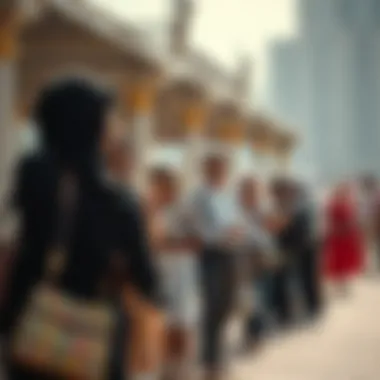

Impact on Traffic Flow
An often overlooked aspect of the Abra Station's role is its positive impact on traffic flow. By providing an alternative river crossing, it alleviates the burden on the road networks that might otherwise be snarled with congestion. This is particularly significant during peak hours when the streets are lined with cars, honking their horns in a symphony of frustration.
Utilizing the abra service reduces the number of vehicles on the road, lessening the risk of gridlock. Imagine a morning rush hour—while cars inch forward, those at the Abra Station glide across the creek, arriving on the other side swiftly. This efficiency not only saves time for commuters but also contributes to a cleaner environment, with fewer cars emitting pollutants. Moreover, the charm of traveling by abra invites locals and tourists to enjoy the scenic views, making the journey itself a memorable experience.
The Abra’s efficiency is crucial in promoting a sustainable urban mobility strategy, as it directly reduces reliance on personal automobiles.
With so many benefits, the Bur Dubai Abra Station is more than just a transport hub; it embodies the spirit of urban mobility and community connection in Dubai. Whether it’s for practical reasons or leisurely exploration, its role is vital in weaving the fabric of this bustling city's ongoing story.
Tourism and Bur Dubai Abra Station
Tourism plays a pivotal role in elevating the significance of Bur Dubai Abra Station, not merely as a transit point but as a cultural nexus that nurtures both local heritage and visitor engagement. With Dubai emerging as a hotspot for global travelers, the Abra Station stands unique, offering a glimpse into the past while serving the needs of modern transport. This demographic blend enriches the station's environment, making it an attraction in its own right, pulsating with life and historical relevance.
Attractions Near the Station
When delving into the attractions surrounding Bur Dubai Abra Station, one finds a treasure trove of experiences that reflect Dubai's rich tapestry of history and culture.
- Dubai Museum: Just a stone's throw away, the Dubai Museum is housed in Fort Al Fahidi, one of the city’s oldest buildings. It provides a fascinating perspective on the city’s transformation from a humble fishing village to a bustling metropolis.
- Al Fahidi Historical Neighborhood: This area boasts preserved traditional homes and winding alleyways, perfect for those looking to experience the architectural beauty of the Emirates. Visiting it is like stepping back in time, where visitors can witness the lifestyle of Dubai’s early residents.
- Textile Souk: A visit here offers a sensory delight with vivid colors and intricate patterns. The souk features a plethora of shops selling everything from vibrant silk to cozy pashminas, representing the rich cultural mix of the city.
- Spice Souk: Adjacent to the textile souk, it tempts the senses with an array of spices, dried fruits, and fragrances, transforming a simple walk into a flavorful journey.
Through these attractions, Bur Dubai Abra Station serves as more than just a transport hub; it creates an ecosystem that celebrates Dubai's past, making it a natural magnet for tourists eager to absorb the city’s rich history and vibrant culture.
User Demographics
Understanding the user demographics is crucial for appreciating Bur Dubai Abra Station's role in the urban landscape. The station attracts a diverse mix of travelers, each with unique needs and preferences:
- Local Residents: Many residents use the abra boats daily for commuting, contributing significantly to the station's foot traffic. Their knowledge of the area’s historical context can enhance the experience for tourists.
- Tourists: Tourists seeking a quick yet immersive trip often flock to the station to cross Dubai Creek. Their demographic spans across all ages and nationalities, reflecting Dubai's global image. This diversity creates a vibrant atmosphere, fostering exchanges between locals and visitors.
- Business Travelers: Those attending trade shows or meetings in the area appreciate the practicality and efficiency of using the abra services to navigate the city without the hassle of traffic.
This rich mix of visitors bolsters the local economy by not only promoting tourism but also supporting small businesses and cultural initiatives surrounding the station. The marriage of tradition and progress at Bur Dubai Abra Station provides both a practical and enriching travel experience, solidifying its place as a key player in Dubai's growth and cultural exchange.
Challenges Facing Abra Station
Bur Dubai Abra Station stands as a unique testament to Dubai's cultural and historical fabric. However, like any transportation hub, it is not without its challenges. Addressing these obstacles is crucial to maintaining its operational effectiveness and ensuring a positive experience for users. Here, we delve into the significant hurdles that Bur Dubai Abra Station faces, highlighting the infrastructure limitations and environmental considerations that need attention.
Infrastructure Limitations
One of the most pressing challenges confronting the Abra Station revolves around its infrastructure. While the abra boats provide a charming and traditional mode of transport, the station itself is somewhat lacking in modern amenities. For example, the waiting areas could benefit from improvements; there’s a distinct absence of climate control, which can be uncomfortable, particularly during the hot summer months.
Additionally, the docks are often congested. Passengers sometimes experience long wait times, especially during peak hours. The physical space allotted for boarding and disembarking can lead to confusion and frustration. A lack of clear signage and information can leave newcomers feeling adrift.
The structurally sound but somewhat aging infrastructure needs investment for redesign and upgrades. Modernizing the station and its facilities can enhance the user experience, potentially attracting a wider audience. A revamp might include:
- Improved waiting areas with air conditioning
- Better signage for ease of navigation
- Enhanced accessibility features for people with disabilities
Investing in these upgrades not only boosts passenger satisfaction but may also positively affect the local economy as more visitors are likely to engage with the transportation's cultural aspects.
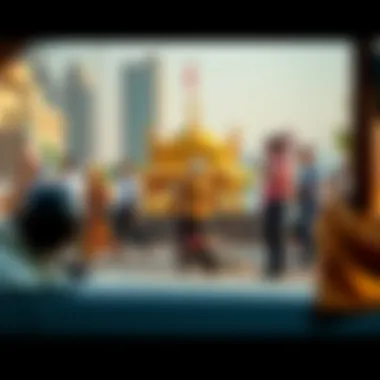

“The connection between a city’s infrastructure and its culture is undeniable; it's not just about transport but the experience.”
Environmental Considerations
Environmental issues rank high on the agenda when addressing challenges at the Bur Dubai Abra Station. As tourism continues to surge, so does the impact on the delicate ecosystems surrounding the waterway. The abra boats, while wooden and traditional, contribute to local pollution, both in terms of noise and possibly water quality.
The increasing boat traffic raises concerns about water quality in the Dubai Creek, which has historically been a lifeblood for the community. The sheer volume of boats can disturb aquatic life. There’s also the matter of waste management, as some visitors may neglect to dispose of their rubbish properly in the vicinity.
To tackle these environmental challenges, the following considerations could be pursued:
- Implementing regular maintenance programs for the creek's cleanliness
- Adopting greener technologies for the abra boats, such as electric engines
- Raising awareness among users about responsible travel and waste disposal
Through adopting environmentally sustainable practices, the station could shift towards a more eco-friendly operation, resonating with a growing demographic of environmentally conscious travelers.
In summary, addressing these challenges—whether they concern infrastructure or environmental impact—is vital for the future of Bur Dubai Abra Station. Strategies to enhance user experience while ensuring ecological sustainability could pave the way for a more prosperous and inclusive community transport hub.
Future Prospects of Bur Dubai Abra Station
The future of Bur Dubai Abra Station seems bright, reflecting both the city’s ambitions and the growing demands of its residents and visitors. As Dubai continues to evolve, the Abra Station stands to play an even more significant role in the urban landscape. This section delves into the potential enhancements and improvements that could reshape the way people use and connect with this unique transportation hub.
Planned Developments
Several exciting developments are on the horizon for Bur Dubai Abra Station. City planners and the local government are looking to integrate more facilities and services to enhance the user experience. For instance, there are discussions around expanding waiting areas and improving accessibility for all, including those with disabilities. Not only does this focus on inclusivity, but also aims to make the station more user-friendly.
- Infrastructure Upgrades: Plans have been set in motion for upgrading facilities with modern amenities. Enhanced waiting rooms, improved signage, and even added refreshment kiosks are just a few ideas on the table.
- Increased Frequency: To cater to the rising number of users, an increase in the frequency of Abra rides is being considered. This could improve connectivity not just within Bur Dubai, but also to surrounding areas, allowing for seamless transitions throughout the city.
- Cultural Displays: Integrating cultural artwork and exhibitions within the station can serve as an opportunity to educate visitors about Dubai's rich history. This would tie into the cultural significance of the Abra itself, creating a more immersive experience for passengers.
These developments could turn Bur Dubai Abra Station not just into a transit point, but a destination in itself, where history and modernity coalesce for all who pass through its doors.
Potential Impact of Technological Advances
As we step further into the digital age, technological advances hold tremendous potential to enhance operations at Bur Dubai Abra Station. Adopting new technologies could lead to a more efficient, convenient, and user-friendly experience.
- Smart Ticketing Systems: Implementing smart ticketing not only makes transactions smoother but also can lead to better data collection. Information on peak times and user demographics can help in adjusting services according to demand.
- GPS Real-Time Updates: Using GPS technology to provide real-time updates about Abra schedules through mobile applications can drastically improve the flow of information. This would allow users to plan their journeys more effectively, reducing waiting times and enhancing the overall experience.
- Eco-friendly Innovations: Considering the significance of environmental sustainability, integrating eco-friendly practices could reshape perceptions about public transport. For instance, using solar energy for operations and encouraging electronic payment methods could substantially lessen the carbon footprint.
In summary, at the crossroad of tradition and innovation, the Bur Dubai Abra Station is poised for significant transformation, reflecting Dubai’s growth and adapting to the ever-changing landscape of urban transportation. By fostering advancements in infrastructure and technology, this station can enhance its role as a vital link connecting various facets of the city's rich tapestry.
Finale
As we wrap up our exploration of Bur Dubai Abra Station, it’s essential to reflect on its fundamental role as a nexus of connectivity and cultural exchange in Dubai. The station is not merely a transport hub; it serves as a cherished link between the past and the present, weaving a tapestry of history that informs the contemporary urban landscape.
Summarizing Key Insights
The Abra Station offers a plethora of benefits that go far beyond its operational efficiency. Here are some pivotal takeaways:
- Cultural Significance: The Abra boats have long been a conduit for both locals and tourists, representing an authentic mode of transportation that is deeply intertwined with Dubai’s rich history.
- Economic Impact: By facilitating easy access to key attractions, it boosts local businesses and stimulates tourism, playing a vital role in the economy of Bur Dubai.
- Sustainable Mobility: The use of traditional abra boats presents a low-impact transport option that aligns with the city's commitment to sustainability, reducing vehicular congestion on the roads.
- Integration with Transit Systems: The Abra Station seamlessly connects with other public transportation systems, reinforcing its role in enhancing urban mobility across Dubai.
Final Thoughts on Regional Connectivity
In wrapping up, it's clear that Bur Dubai Abra Station stands as a testament to the city's past, whilst serving its present and future. For investors and property managers, the continued relevance of this transport hub signifies a living, breathing part of Dubai's urban fabric that influences property values and development potential.
- Investment Opportunities: Properties in proximity to the Abra Station are likely to see increased demand, as both tourists and locals alike seek accessible avenues to engage with the city’s vibrant culture.
- Future Growth Potential: With planned developments and ongoing enhancements in transportation infrastructure, the area surrounding Bur Dubai Abra Station is poised for upward growth, offering enticing prospects for savvy investors.
As Dubai continues to evolve, Bur Dubai Abra Station will remain integral to the ongoing narrative of connectivity, culture, and urban life in this dynamic city. For those looking to tap into the potential of this vibrant area, paying attention to the historical and present significance of this station could provide invaluable insights into the city's trajectory.
